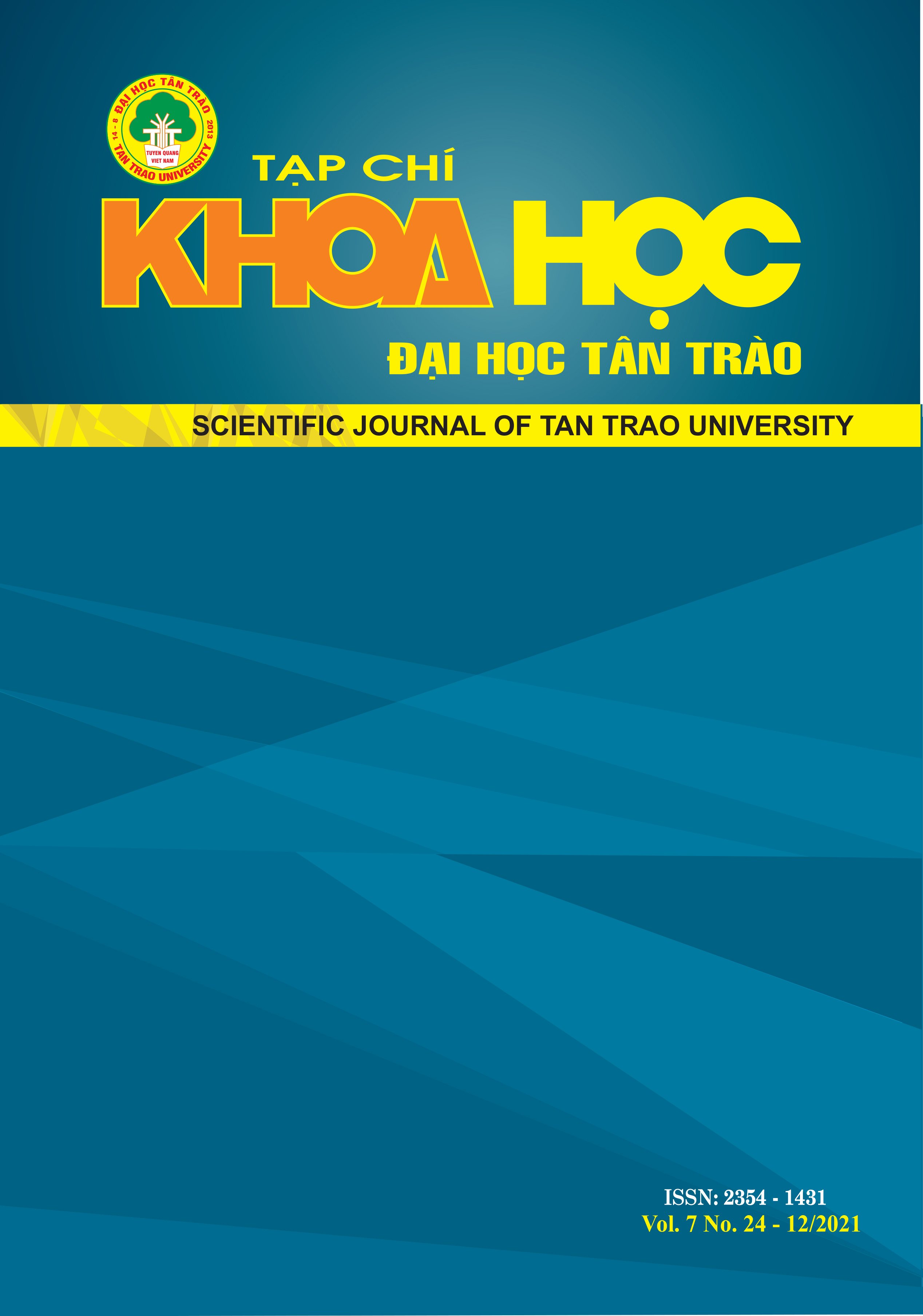PHƯƠNG PHÁP CHIẾU GIẢI BÀI TOÁN BẤT ĐẲNG THỨC BIẾN PHÂN GIẢ ĐƠN ĐIỆU MẠNH
DOI:
https://doi.org/10.51453/2354-1431/2021/610Tóm tắt
Bài toán bất đẳng thức biến phân có nhiều ứng dụng quan trọng trong các lĩnh vực xử lý tín hiệu, xử lý ảnh, điều khiển tối ưu và nhiều ứng dụng. Trong bài báo này, chúng tôi giới thiệu hai thuật toán để giải các bất đẳng thức biến phân giả đơn điệu mạnh. Phương pháp mới cải thiện một số thuật toán hiện có. Các thuật toán của
chúng tôi sử dụng cỡ bước tự thích nghi, được xây dựng dựa trên thông tin của bước trước và sự hội tụ mạnh của các phương pháp này được chứng minh mà không cần tính liên tục Lipschitz của các ánh xạ giá. Chúng tôi tiến hành một vài thử nghiệm số để minh họa tính hiệu quả của các thuật toán mới
Tải xuống
Tài liệu tham khảo
[1] Anh, P.K., Hai, T.N. (2017). Splitting extragradient-like algorithms for strongly pseudomonotone equilibrium problems. Numer. Algorithms, 76: 67-91.
[2] Anh, P.N., Hai, T.N, Tuan, P.M. (2016). On ergodic algorithms for equilibrium problems.
J. Global Optim., 64: 179-195.
[3] Anh, P.K., Vinh, N.T.: Self-adaptive gradient projection algorithms for variational inequalities involving non-Lipschitz continuous operators. Numer. Algorithms, DOI
1007/s11075-018-0578-z.
[4] Bao, T.Q., Khanh, P.Q. (2005). A projectiontype algorithm for pseudomonotone nonlipschitzian multi-valued variational inequalities. Nonconvex Optim. Appl., 77: 113-129.
[5] Bauschke, H.H., Combettes, P.L. (2011). Convex Analysis and Monotone Operator Theory
in Hilbert Spaces. Springer, New York.
[6] Bello Cruz, J.Y., Iusem, A.N. (2010). Convergence of direct methods for paramonotone variational inequalities. Comput. Optim. Appl., 46: 247-263.
[7] Bello Cruz, J.Y., Iusem, A.N. (2009): A strongly convergent direct method for monotone variational inequalities in Hilbert spaces. Numer. Funct. Anal. Optim., 30: 23-36.
[8] Bello Cruz, J.Y., Iusem, A.N. (2012). An explicit algorithm for monotone variational inequalities. Optimization, 61: 855-871.
[9] Censor, Y., Gibali, A., and Reich, S. (2011). The subgradient extragradient method for
solving variational inequalities in Hilbert space. J. Optim. Theory and Appl., 148: 318-
[10] Facchinei, F., Pang, J.-S. (2003). Finitedimensional variational inequalities and complementarity problems. Springer, New York.
[11] Hai, T.N. (2020). On gradient projection methods for strongly pseudomonotone variational inequalities without Lipschitz continuity. Optim. Lett. 14:1177–1191.
[12] Hai, T.N. (2021). Linesearch-free algorithms for solving pseudomonotone variational inequalities. Pacific Journal of Optimization, 17(2): 269-288.
[13] Hai, T.N. (2021). A simple fork algorithm for solving pseudomonotone non-Lipschitz variational inequalities. International Journal of Computer Mathematics, 98(9): 1807-1820.
[14] Hai, T.N. (2020). Two modified extragradient algorithms for solving variational inequalities.
Journal of Global Optimization, 78(1): 91-106.
[15] Hai, T.N., Vinh, N.T. (2017). Two new splitting algorithms for equilibrium problems. Rev.
R. Acad. Cienc. Exactas F‰s. Nat. Ser. A Math. RACSAM, 111: 1051-1069.
[16] Iiduka, H. (2010). A new iterative algorithm for the variational inequality problem over the fixed point set of a firmly nonexpansive mapping. Optimization 59: 873-885.
[17] Iiduka, H. (2012). Fixed point optimization algorithm and its application to power control in CDMA data networks. Math. Program., 133: 227-242.
[18] Iiduka, H., Yamada, I. (2009). An ergodic algorithm for the power-control games for CDMA
data networks. J. Math. Model. Algorithms, 8: 1-18. 7N.T. Dinh/No.xx_Mar 2022|p.xxx–xxx
[19] Khanh, P.D., Nhut, M.B. (2018). Error bounds for strongly monotone and Lipschitz continuous variational inequalities. Optim. Lett., 12: 971–984.
[20] Khanh, P.D., Vuong, P.T. (2014). Modified projection method for strongly pseudomonotone variational inequalities. J. Global Optim., 58: 341-350.
[21] Kim, D.S., Vuong, P.T., Khanh, P.D. (2016). Qualitative properties of strongly pseudomonotone variational inequalities. Optim. Lett., 10: 1669-1679.
[22] Kinderlehrer, D., Stampacchia, G. (1980). An Introduction to Variational Inequalities
and Their Applications. Academic Press, New York.
[23] Korpelevich, G.M. (1976). The extragradient method for finding saddle points and other
problems. Ekon. Mat. Metody., 12: 747-756.
[24] Malitsky, Y. (2015). Projected reflected gradient methods for monotone variational inequalities. SIAM J. Optim., 25: 502–520.
[25] Santos, P., Scheimberg, S. (2011). An inexact subgradient algorithm for equilibrium problems. Comput. Appl. Math., 30: 91-107.
[26] Solodov, M.V. (2003). Merit functions and error bounds for generalized variational inequalities. J. Math. Anal. Appl., 287: 405-414.
[27] Solodov, M.V., Svaiter, B.F. (1999). A new projection method for monotone variational
inequality problems. SIAM J. Control Optim., 37: 765-776.
[28] Thuy, L.Q., Hai, T.N. (2017). A Projected Subgradient Algorithm for Bilevel Equilibrium
Problems and Applications. J. Optim. Theory Appl., 175: 411-431.
Tải xuống
Đã Xuất bản
Cách trích dẫn
Số
Chuyên mục
Giấy phép

Tác phẩm này được cấp phép theo Giấy phép Quốc tế Creative Commons Attribution-ShareAlike 4.0 .
Bài báo được xuất bản ở Tạp chí Khoa học Đại học Tân Trào được cấp phép theo giấy phép Ghi công - Chia sẻ tương tự 4.0 Quốc tế (CC BY-SA). Theo đó, các tác giả khác có thể sao chép, chuyển đổi hay phân phối lại các bài báo này với mục đích hợp pháp trên mọi phương tiện, với điều kiện họ trích dẫn tác giả, Tạp chí Khoa học Đại học Tân Trào và đường link đến bản quyền; nêu rõ các thay đổi đã thực hiện và các nghiên cứu đăng lại được tiến hành theo cùng một bản quyền.
Bản quyền bài báo thuộc về các tác giả, không hạn chế số lượng. Tạp chí Khoa học Tân Trào được cấp giấy phép không độc quyền để xuất bản bài báo với tư cách nhà xuất bản nguồn, kèm theo quyền thương mại để in các bài báo cung cấp cho các thư viện và cá nhân.
Mặc dù các điều khoản của giấy phép CC BY-SA không dành cho các tác giả (với tư cách là người giữ bản quyền của bài báo, họ không bị hạn chế về quyền hạn), khi gửi bài tới Tạp chí Khoa học Đại học Tân Trào, tác giả cần đáp ứng quyền của độc giả, và cần cấp quyền cho bên thứ 3 sử dụng bài báo của họ trong phạm vi của giấy phép.






